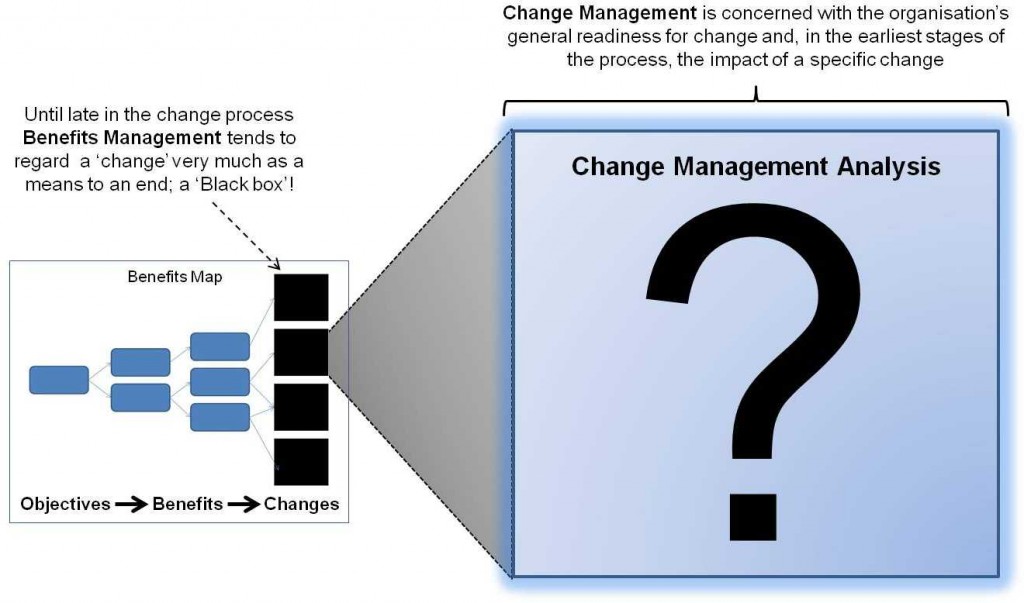It is apparent that there is so much that can be done to understand the needs of a given change such that, for every facet for which an understanding is achieved, a reduction in the risk of its failure or an easing of its passage is gained. This pragmatic perspective also suggests that, to be effective, a Change Manager must have a minimum set of skills and qualities; Kanter (1989, cited in Buchanan & Huczynski, 2004 p.634) suggests that these include:
- ability to work independently, without management power, sanction and support
- an effective collaborator able to compete in ways that enhance cooperation
- the ability to develop high trust relationships, based on high ethical standards
- self-confidence, tempered with humility
- respect for the process of change, as well as the content
- able to work across business functions and units, ‘multifaceted and ambidextrous’
- the willingness to stake reward on results and gain satisfaction from success
It is possible to relate these attributes to many management roles but the important point to note here is that the management subject and context is ‘change’ i.e. helping organisations and people to do things differently.
The need to see things from the perspective of others plays an important role in enabling and progressing change (Paton and McCalman, 2008) with this in mind, and based upon his personal experience, the author would also add the ability to empathize with people to this list. This suggests that a Change Manager may well be more effective if they have working knowledge of the practices in the arena in which they are operating and also that they have non-change related man management experience.
During a formal discussion of a change related topic it is the Change Manager; with no other agenda except the successful outcome of the change effort, who speaks out, albeit in context, in support of the specific change management need. Not an easy proposition because as Machiavelli, quoted in De Caluwé and Vermaark (2003), writes:
‘nothing is more difficult to take on, more precarious to lead, or less certain of success than introducing new things, because the person introducing them makes an enemy of those who fared well under the old situation and those that might fare well under the new situation do not (yet) defend it zealously’
Although certain aspects of change management will be apparent in functional areas of an organisation such as Engineering & Project Management i.e. measurement, control, impact assessment etc. they would not be generally recognisable as pertaining to the science of change management. It is the willingness of the Change Manager to take on multiple and sometimes conflicting agendas seen as necessary for them to be successful change agents that sets them apart from other arbiters of change in an organisation (Buchanan and Boddy, 1992).
No different from another occupation, Change Managers are always learning and there is no shame in having weaknesses or even gaps in experience that need filling. But paramount is the need for the Change Manager, with often so much at stake, to be able to operate as a neutral force for good (Paton and McCalman, 2008), declaring when appropriate, limitations which, if left unacknowledged, could adversely impact the performance of a given change. A consequence of this is that the Change Manager must be prepared to grow in the role and constantly learn from his experiences. Kolb (1984 p.1) states that:
‘our survival depends on our ability to adapt not only in the reactive sense of fitting into the physical and socials worlds, but in the proactive sense of creating and shaping those worlds’
This must surely be the case for the Change Manager who, using his own individual change management style must work to do what is required to achieve a given change within the presented context. The Change Manager must leverage his knowledge and interpretation of the available reference material to analyze the prevailing change scenario and provide a service such that an appreciative but effective understanding is gained and an appropriate strategy produced and successful outcome achieved. This fundamentalist stance, when coupled with ‘whole solution’ cyclic approaches that include such stages as problem definition, context, diagnosis, intervention and monitoring, together provide the Change Manager with a basic framework and toolkit with which to work.
Stages may be revisited iteratively, as the change initiative progresses to enable the change environment and context to be fully revealed and reconciled. Within this cycle other models can be used to learn from experiences and feed that learning back to produce an evolved way of working (Buckler, 1996 cited in Paton and McCalman, 2008) (Kolb, 1984) (Argyris, 1977a).
References:
Buchanan, D & Huczynski, A (2004) Organizational Behaviour, An Introductory Text, 5th edit, Harlow, England, Pearson Education Ltd
Paton, R and McCalman, J (2008) Change Management – A Guide to Effective Implementation, 3rd edit, London, Sage Publications Ltd
De Caluwé, L and Vermaark, H (2003) Learning to Change: A Guide for Organization Change Agents, London, Sage Publications
Buchanan, D & Boddy, D (1992) The expertise of the Change Agent, Public Performance and Backstage Activity, 1st edit, Hemel Hempstead, England, Prentice Hall International (UK)
Kolb, D (1984) Experiential Learning, New Jersey, Prentice-Hall, Inc
Argyris, C (September-October 1977a) Double loop learning in organizations, Harvard Business Review, pp. 115-125


